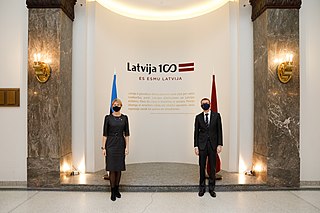 W
WThe Art Nouveau architecture in Riga makes up roughly one third of all the buildings in the centre of Riga, making Latvia's capital the city with the highest concentration of Art Nouveau architecture anywhere in the world. Built during a period of rapid economic growth, most of Riga's Art Nouveau buildings date from between 1904 and 1914. The style is most commonly represented in multi-storey apartment buildings. Stylistic influences derived not least from present-day Austria, Finland and Germany, while the establishment of a faculty of architecture in Riga in 1869 was instrumental in providing a local cadre of architects. This included, but was not limited to, some of the first formally trained ethnic Latvian architects. As elsewhere, the Art Nouveau movement in Riga was driven by a desire to express greater individuality, local attachment and a more rational kind of architecture than that which had dominated during the 19th century. Stylistically, the Art Nouveau architecture of Riga can be further divided into four different stages: Eclectic, Perpendicular, National Romantic; and Neo-Classical.
 W
WBaltic Unity day or Balts' Unity Day is a commemorative day celebrated on September 22 in Lithuania and Latvia, as well as Latvian and Lithuanian communities abroad. It was recognized as such in 2000 by both the Seimas of Lithuania and Saeima of Latvia commemorating the 1236 Battle of Saule, where the joint pagan Samogitian and Semigallian forces decisively defeated the Livonian Brothers of the Sword.
 W
WThe Cabinet of Folksongs or the Cabinet of Dainas is a cabinet 160 cm (63 in) tall, 66 cm (26 in) wide, and 42 cm (17 in) deep, in which all Latvian folksongs (dainas) collected by Latvian folklorist Krišjānis Barons are stored. The cabinet itself was made in Moscow in 1880 after Barons' draft. In 2001, the Cabinet of Folksongs was included in the UNESCO Memory of the World Register.
 W
WLatgalian pottery or Latgalian ceramics, also known as Silajāņi ceramics is the best-known subset of Latvian pottery. The region of Latgale historically has been the most prolific producer of wares. Latgalian ceramics rose to the popularity in the Soviet period, when art historian Jānis Pujāts wrote books about the best Latgalian ceramicists and organized several exhibitions to showcase their works.
 W
WThe 100th Anniversary of the Latvian Republic also commercialized as Latvia 100 is a national event in Latvia celebrating the country's 100th anniversary since its 1918 establishment. The main celebrations were held on 18 November 2018, and other commemorative events are set to take place from 2017-2021. Outside from the official celebrations, 18 November is also a public holiday, being the Proclamation Day of the Republic of Latvia.
 W
WThe Latvian National Opera and Ballet (LNOB) is an opera house and opera company at Aspazijas boulevard 3 in Riga. Its repertoire includes performances of opera and ballet presented during the season which lasts from mid-September to the end of May. During a typical season, LNOB presents almost 200 performances, including, on average, 6 new productions. The largest is the Great Hall which houses 946 seats, while the smaller ones - the New Hall, the Dress Circle Hall (Beletāžas zāle) and the Red Hall - have a maximum seating capacity of 338, 170 and 100 respectively. LNOB employs a total of approximately 600 people. The building is located on the bank of the Riga Canal, near the Freedom Monument. As of November 5, 2019, the chairman of the board is Egils Siliņš, a world renowned opera singer. The chief conductor since 2013 is Mārtiņš Ozoliņš who is also an associate professor at the Jāzeps Vītols Latvian Academy of Music. The artistic director since 1993 is Aivars Leimanis.
 W
WLatvian pottery or Latvian ceramics is one of the country's oldest art forms, dating back to the Neolithic. The best-known subset of Latvian pottery is Latgalian pottery. The eastern region of Latgale is the most prolific producer of wares.
 W
WThe Namejs ring is a traditional Latvian ring which represents Latvian independence, friendship and trust, and symbolizes the unity of three ancient Latvian lands – Kurzeme, Latgale and Vidzeme.
 W
WThe National Library of Latvia, also known as Castle of Light, is a national cultural institution under the supervision of the Ministry of Culture of Latvia. The National Library of Latvia was formed in 1919 after the independent Republic of Latvia was proclaimed in 1918. The first supervisor of the Library was Jānis Misiņš, a librarian and the founder of the Latvian scientific bibliography (1862–1945). The current building was designed in 1989 by noted Latvian-American architect Gunnar Birkerts (1925-2017), who emigrated to the United States and made his career there. It was constructed in the early 21st century and opened in 2014. Today the Library plays an important role in the development of Latvia's information society, providing Internet access to residents and supporting research and lifelong education.
 W
WThe main religion traditionally practiced in Latvia is Christianity. As of 2011, it is the largest religion (80%), though only about 7% of the population attends religious services regularly. Lutheranism is the main Christian denomination among ethnic Latvians due to strong historical links with the Nordic countries and Northern Germany, while Catholicism is most prevalent in Eastern Latvia (Latgale), mostly due to Polish influence. The Latvian Orthodox Church is the third largest Christian church in Latvia, with adherents primarily among the Russian-speaking minority.